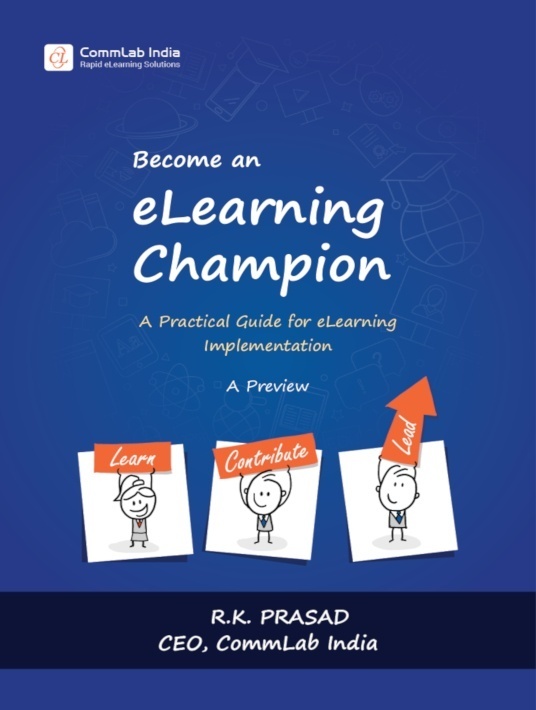A Question As Old As Time
You are ready to begin your new eLearning scheme. Should you outsource or develop in-house? This question is as old as time...or as old as eLearning, at least. The choice to build your eLearning courses in-house versus outsourcing to a vendor is a decision that should not be taken lightly. While it’s usually easy to get a sign-off for in-house development, it’s a herculean task to get the same for outsourcing eLearning development. Not every organization wants to pay an eLearning vendor for developing their custom eLearning courses [1].

At the same time, in-house development might not be the solution when your own resources aren’t adequate for the task. Sometimes, outsourcing eLearning development makes more sense, and sometimes, doing it in-house wins hands down. So, let’s explore both these options and settle the in-house vs. outsourcing debate.
In-House Vs. Outsourcing eLearning Development
In-House eLearning Design And Development
When you develop eLearning courses in-house, you are going to design and develop the courses using your own resources, with little or no help from outside. In this case, you should either have an in-house team or hire people for specific roles. Having an existing in-house team is a good thing because you will be able to:
- Develop customized eLearning courses
Your in-house team will have a better understanding of the specific needs of your organization. It’s going to be a lot easier for them to deliver exactly what you’re looking for and make updates or changes faster. Moreover, an in-house team also makes communication simpler and easier. - Manage costs better
Developing eLearning courses will be less expensive, especially when you need to develop multiple courses. Since you already have a team, you don’t need to plan for allocating additional budget for a vendor. - Maintain data confidentiality
In-house development is definitely a safer option if you are worried about highly confidential training content.
However, if you’re just getting started with eLearning and want to form an in-house development team, costs will shoot up. Let’s find out why.
- Hiring new talent
eLearning development requires different skillsets to ensure its success. You will need Project Managers, Instructional Designers, visual designers, and courseware developers to form a basic team. The number of people involved will again depend on the scale of the project. Moreover, having an in-house team is unnecessary if you don’t have continuous development projects. - Training the team
Your job is not done with forming a development team; you also need to train them. This is going to call for a lot of planning, effort, and time. - Investing in new tools and technology
Your Instructional Designers and courseware developers will need software tools—eLearning authoring tools, audio/video editing tools—to convert storyboards into fully functional eLearning courses [2]. And needless to say, these tools don’t come cheap, and neither do the licensing costs for some of them.
Moreover, course development is just one part of a workplace training program. There are many more processes and tools involved—memory tools for translation, an LMS for hosting and tracking courses, and more. You will also need to improve your IT infrastructure and provide support for LMS administration.
But, here’s the thing. You can choose to avoid all these and make development hassle-free by outsourcing to an eLearning vendor. It is definitely a better option when you lack the skills and resources to develop courses in-house. Outsourcing eLearning development to a vendor also helps you roll out effective courses quickly. Let’s look at some of the benefits that outsourcing has to offer.
Outsourcing eLearning Design And Development
According to the 2019 Training Industry report [3], large companies spent an average of $1.5 million on outsourcing. Instruction/facilitation was divided almost equally between in-house (47%) and outsourcing (53%). The benefits of outsourcing eLearning development have made outsourcing the preferred option for most organizations of all sizes. Here are some of those benefits:
- Access to a pool of experts
When you outsource eLearning design and development, you get to partner with experts having a strong background in training, Instructional Design, authoring tools expertise, and more [4]. They will have a huge pool of resources which will make it easy to scale up development. - Faster turnaround time
A capable overseas vendor will leverage the differences in time zones to ensure quick development. Their strong remote Project Management and robust QA processes will ensure the development proceeds smoothly, without any delays. - Training updates
Outsourcing will also give you access to eLearning experts ("training consultants") and help you understand "trends" [5]—how they fit in your training requirements and the optimal way to use them, rather than including them in your training just because everyone else seems to be doing it.
And the good news is, you now have the flexibility of picking and choosing the best vendor for each of your outsourcing needs. If you don’t want to outsource the complete design and development project, you can outsource just the component where your in-house lacks expertise, such as:
- Flash to HTML5 conversion
- eLearning translation
- Rapid development from production-ready storyboards
- Development of videos and other media assets
To reiterate, here’s a quick summary to help you decide between developing courses in-house and outsourcing them.
| Why | When | |
| In-House eLearning Development |
|
|
| Outsource eLearning Development |
|
|
While in-house development gives you full control of the development process, it comes at a cost of time and money. Meanwhile, outsourcing eLearning development allows you to roll out effective courses quickly without having to worry about time or quality.
While some organizations do everything in-house, you might want to outsource the entire development process. Exploring both sides in the context of what works best for your organization should help you make an informed decision. If you want to explore eLearning further, here’s what you need to do.
Get the book Become An eLearning Champion: A Practical Guide For eLearning Implementation for practical insights, implementation ideas, best practices, and more. This eBook is a distillation of CommLab India’s 20 years of experience in Instructional Design, eLearning, corporate training, and technology-enabled learning. You can also download a preview of the first chapters and watch the relevant webinar for a more in-depth analysis.
References:
[1] Why Is Investing In Custom eLearning Courses The Right Choice?
[2] Top Authoring Tools For Rapid eLearning Development—Do You Know About Them?
[3] 2019 Training Industry Report
[5] 5 eLearning Trends To Look Out For In 2020










